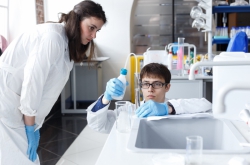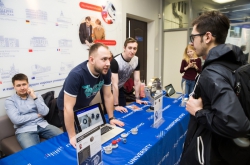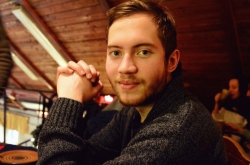The BASIS foundation was established by Russian entrepreneur Oleg Deripaska in 2016. The foundation’s programs are aimed at several categories of scientists and science events. That includes, for instance, individual grants for scientists at various stages of their careers, with a special focus on young scientists. Other goals include the support of the scientific community, e.g. participation in programs, conferences and schools, the support for scientific and educational events and more. Both PhD students and Candidates of Science can apply for these grants. Applicants have to propose a research project in the field of fundamental physics that corresponds to a preset topic, present publications in international science journals during a particular time period, as well as recommendation letters from Russian and international scientists working in the relevant field of research.
This year’s personal grants were given to two research associates of ITMO’s Department of Nanophotonics and Metamaterials: Andrei Bogdanov and Maxim Gorlach. Andrei Bogdanov’s project deals with localized optical states in the continuum in periodic dielectric structures. Continuum is a relatively new object in optics that has only been being actively researched in the past decade. Continuum localized states can be used to intensify the impinging radiation by millions of times. This can be used in the creation of nonlinear optical elements and ultrasensitive biosensors. According to the researcher, his project analyzes fundamental problems related to practical applications of these states. Andrei Bogdanov is a research advisor to PhD students Kirill Koshelev, Zarina Sadrieva and Oleg Ermakov, who also received the foundation’s support in the past two years.

Maxim Gorlach, a junior research associate at ITMO’s International Research Center for Nanophotonics and Metamaterials and another grant winner, is conducting research on topological photonics. In layman’s terms, topological photonics can be described using the following example: a mathematician can say that two surfaces are “topologically equivalent”. This means that by constantly deforming one of these surfaces, we can create a copy of the other. This doesn’t work with certain surfaces: for example, a sphere and a torus would not be topologically equivalent. This concept is applicable to physics, as well. For example, the topology of photonic bands is a source of such unique properties of artificial structures as topologically-protected edge states. Such states emerge strictly along the structures’ edge, never going deeper or leaving the structures’ boundaries. Topological states of light have several curious properties that have been researched by ITMO scientists in the recent years. Among other things, ITMO’s researchers developed topological defect detection methods and contributed to designing a 3D topological insulator. What is more, Alexander Poddubny and Maxim Gorlach made an interesting prediction: the existence of interaction-driven edge states of bound two-photon quasiparticles in a dimer periodic array of nonlinear optical cavities. Such a prognosis contradicts common intuition, as the emergence of bound states usually implies the involvement of attraction, but still complies with the laws of physics. With support from the BASIS foundation, Maxim Gorlach plans to initiate experimental research in this field.

This year, 19 young Russian researchers won grants in the “PhD student” category. The four winners from St. Petersburg are all representatives of ITMO’s International Research Center for Nanophotonics and Metamaterials. As of today, nine of the university’s PhD students have been awarded the BASIS scholarship since the launch of the foundation’s grant program, an accomplishment that no other university or institution of the Russian Academy of Sciences can boast of. Among this year’s winners is Daniil Kornovan, PhD student at the Department of Nanophotonics and Metamaterials who does theoretical research on the different aspects of light-matter interaction.
“For example, there is a task related to optical powers that affect single atoms or small particles in vicinity of thin optical fibers. Its application is quite obvious: it offers a means of optical manipulation of micro- and nano-objects. There are also tasks that have to do with studying how emission properties of single quantum sources (like atoms and quantum dots) and their ensembles change when they react with eigen modes of different photonic structures. This research is more fundamental: in this case, we’re not set on inventing some particular device. Nevertheless, research on such systems’ properties is important for developing future photonic devices,” explains the PhD student.

The young scientists plans to use the grant money for participating in the Okinawa School in Coherent Quantum Dynamics, which will be held at the Okinawa Institute of Science and Technology this autumn.
Grant winner Zarina Sadrieva’s research project concerns bound states in the continuum (BICs) in optical systems. Those are special topologically protected resonances with a theoretically infinite Q-factor. High Q-factor indicates a lower rate of energy loss relative to the stored energy of the resonator, which has a lot to do with a resonator’s general quality. BICs states can be used to produce resonators with a very high Q-factor.

“By all means, BICs-based optical systems are not the only option for creating resonators with a high Q-factor. But BICs have other advantages; for instance, the ease of excitation and radiation directivity are much better than those of their closest counterparts. The application field of BIC-based resonators is quite wide: from data transfer and processing systems to various ultrasensitive sensors. This topic is quite new: the first articles on BICs in optics were published in 2008. In 2017, the first laser system with a BIC-based resonator was proposed. I do related research as part of my thesis work, so I have good groundwork for further development of this topic. When applying for the grant, I mentioned all of my articles since 2011. They are all related to the project’s topic because I have been doing research on optical resonators since my Bachelor’s years. The most recent articles were published in ACS Photonics and Physical Review Letters,” comments Zarina Sadrieva.





